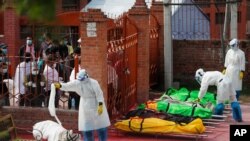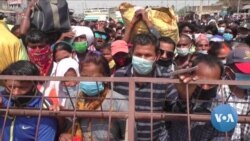Thousands of Nepalese migrants working in India rushed home in recent weeks seeking safe haven from a brutal second wave of the coronavirus pandemic as it battered the country with sickness and death.
Now, the small Himalayan country is confronting a crisis like India’s as its health care system buckles under an exponential rise in infections. Nepalese officials are calling for international assistance as it grapples with shortages of oxygen that have plagued India. Political turmoil after Nepali Prime Minister K.P. Sharma Oli lost a vote of confidence on Monday could make it harder to cope with the pandemic, analysts said.
“A number of people are dying as they search for hospitals or during their treatment,” Samir Kumar Adhikari, a spokesperson for Nepal’s Ministry of Health and Population, told VOA. “Almost all hospitals are packed, and although some have space, we are unable to operationalize them because of shortage of oxygen and other logistics.”
India and Nepal have an open border policy allowing free movement between the two countries — thousands of Nepalis travel for work in Indian cities, while Indians often travel to Nepal for business.
Officials say COVID-19 infections first started to rise in towns like Nepalganj along the Indian border. But Kathmandu Valley where the large cities are situated is now the epicenter of the second wave. Thousands of people have left the capital Kathmandu to return to their villages, raising fears that they will carry the infection and spread it into remote rural areas.
Nepal reported over 9,000 daily infections on Monday — 60 times what the country reported at the start of April when Nepal was counting around 150 daily infections.
A number of border crossings with India have been shut down in recent days. Most international flights have been halted and much of the country is under a lockdown order. Worried residents are lining up for inoculations, but until last month, only about 7% of the population had received one vaccine dose.
“It is a very pathetic situation in Nepal,” Nepal’s Red Cross Chairman, Netra Prasad Timsina told VOA. He says the country urgently needs international assistance to prevent the situation from worsening because the government’s resources are not enough to cope with the pandemic. “Nepal needs all the medical equipment for COVID-19 treatment — oxygen cylinders, concentrators and medicines.”
In a statement last week, Timsina said the situation in India was a “horrifying preview of Nepal’s future if we cannot contain this latest COVID surge.”
Nepal’s health care system is fragile — it has 1,595 intensive care beds and 480 ventilators for its about 30 million people, according to the government.
Political instability is adding to its woes, observers add. On Monday, Prime Minister Oli lost a vote of confidence in parliament paving the way for opposition parties to cobble a new ruling coalition.
Oli had been criticized for playing down the risk of the pandemic and asking citizens to treat the virus with hot water, guava leaves and turmeric powder.
Like in neighboring India, the government is also being blamed for letting down its guard when infections were low — the country was up and running, restaurants and markets were open, crowds gathered to celebrate festivals and Nepal reopened Mount Everest to foreign climbers. Masses political gatherings were held in recent months.
The government failed to prepare adequately for a second wave during the months when there was a lull in infections or for more transmissible variants that would spread more rapidly, public health experts said.
“We should have learned from [the United Kingdom] and Brazil how difficult it would be to contain the rapidly spreading variants and the measures needed to overcome the situation,” said Suresh Panthee of the Sustainable Study and Research Institute in Kathmandu. “Most importantly, once India started to see a rapid increase in cases, Nepal should have been vigilant to test, quarantine, and isolate. We should have seen the coming danger, but we did not.” He says the large political gatherings held in the country in recent months were “inexcusable.”
The virus appears to have traveled to the country’s most famous mountain — a Norwegian climber, Erlend Ness, said last month he had tested positive for COVID-19 at Everest Base camp. Nepalese culture and tourism ministry has however said that there are no health safety risks at the base camp.
The country’s former king, Gyanendra Bir Bikram Shah, and his queen, have been hospitalized after testing positive for COVID-19 following a trip to India in April where he attended the Kumbh mela, a Hindu religious festival that epidemiologists have flagged as a super spreader event.
Residents said they fear the spread of the virus in cities like Kathmandu after following the coverage of how people struggled in India’s hospitals.
“We see ambulances parked outside hospitals, people are not getting a bed,” says Vivek Sherchan, a Kathmandu resident who has tested positive for COVID-19. “We worry that the situation is about to get dire.”
Officials say that most of the infected people are at home without effective surveillance and warn that the country will not be able to cater to them if they need hospital care. The army is expanding health care facilities in border areas with India.
China is sending oxygen cylinders. But Nepal is yet to receive the large-scale international medical aid similar to India. India received assistance from over 40 countries.
“We immediately need international support. Right now, we need oxygen support,” said Adhikari, the country’s health ministry spokesperson. “The ministry of health is unable to address the real situation, real problem in hospitals, real problem in home isolation.”
Officials fear that conditions will only worsen in the coming days if the current trend continues. “We are struggling. The situation is getting out of control,” Adhikari said.








